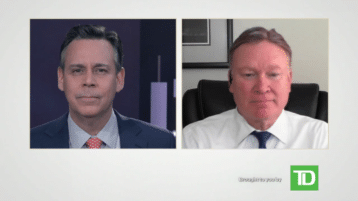Movie theatres are reopening as pandemic restrictions ease, helping to boost box-office ticket sales. Anthony Okolie speaks with Andriy Yastreb, Telecom and Media Analyst at TD Asset Management, about what the economic reopening means for streaming subscribers growth going forward.
Print Transcript
[MUSIC PLAYING]
- Andriy, both Netflix and now Disney have reported quarterly results. But before we get to those results, how have the streaming services been performing versus the broader market this year?
- Hi, Tony. The streaming services so far have been lagging behind the market. As this chart shows, both Netflix and Disney, which operate the largest streaming platforms, are down year-to-date. And even some of the smaller newcomers to the streaming world, such as Viacom, CBS, and Discovery, which had a very strong rally at the beginning of the year, are still lagging behind the S&P 500, which is up almost 19% year-to-date.
- Now, Andriy, one of the key metrics that analysts as well as investors watch closely during earnings season for streamers is the net new subscribers. And both Netflix and Disney beat expectations. But the net adds are still down year-over-year. And as you mentioned, the stocks are underperforming. So give us your take on the latest results.
- Yes, Tony, I think that's a key reason why stocks are underperforming this year. Because if you look at net additions so far this year, both Netflix and Disney missed in Q1 results but beat in Q2. But overall, for the first half, net additions for both services are down year-on-year. And for Netflix, it's quite significantly down. For Disney, they have a benefit that they're still growing in emerging markets, but it's mostly markets where their average monthly revenue per subscriber is $1 or less. And in developed markets, growth is down significantly.
And there are two factors that influence that. The first one is that, because of COVID and lockdown last year, it looks like there was a pull-forward of subscriber additions last year. What it means is that some subscribers who would otherwise subscribe in 2021 decided to subscribe in 2020 because they had to stay home and they had nothing else to do.
- What about the challenges in new content production, as well as the potential for global subscriber acquisition?
- Yes, Tony. So that's the second driver here because COVID disrupted not only our experiences as consumers. It also disrupted production of new content last year. And that's why, in the first half of this year, the content slate released by Disney and Netflix was not as strong as it would be. And because of that, 2021 will become a test to see if content is actually the major driver for subscriber additions for streaming services, because a lot of those TV shows and movies that were delayed in last year, they're now starting to come back on stream. And we'll see a much stronger slate in the second half of this year.
So for Netflix, for example, they will release new seasons of Money Heist, Stranger Things, Witcher, just to name a few, plus, obviously, some new content. And we'll see if this helps these companies to beat expectations and post a rebound in subscriber growth.
And final point I want to make on this is that I think from long-term perspective, the thesis hasn't changed. There's still hundreds of millions of broadband subscribers who pay for fast broadband globally, but they are not yet subscribers to Netflix and Disney. And I think going forward every year, a portion of them will decide to subscribe to this video services.
- So as we see economies reopening, what are the implications for the streaming industry as more and more theaters open up for business?
- I think, in theaters, I think the impact will not be very strong overall. And the reason I'm saying that is, if you look at statistics before COVID, average American went to movies four times a year, and average Netflix subscriber watched two hours of video on Netflix every day. So there is a big difference in consumption here. And, obviously, Netflix is showing a lot more shows versus films. So from that perspective, I don't think there is going to be a big impact on the industry. They're serving very different target audiences and different purposes.
But where I think there might be some impact is for services like Disney+ or HBO Max, where the management of the companies will have to decide whether to release movies in theaters or release them on streaming services, as they've been doing during the pandemic. And if they decide to put them on movies, maybe some of them will have a bit of a shortage of new, exciting content that might drive subscriber additions. But I think it's going to be marginal and company-specific.
- OK, and earlier, you touched about the potential for global subscriber acquisition. What's your outlook for the streaming industry over the next 12 months?
- So as I mentioned before, I think that there's a very long run rate for this industry to grow. As Disney mentioned on their call this week, they said that "we are in first inning of the first game in a very long season." If you look at Netflix, for example, they have just over 200 million subscribers, but we know that there are over 700 million households who subscribe for fast broadband globally outside of China.
So I think the long-term outlook is strong. And for next 12 months, as long as companies are able to make this new content, and to release it, and inspire people to tune in and watch something, I think they'll be doing well. But obviously, that depends on COVID and if we don't see any more disruptions.
- Andriy, thank you very much for joining us.
- Thank you, Tony.
[MUSIC PLAYING]
- Andriy, both Netflix and now Disney have reported quarterly results. But before we get to those results, how have the streaming services been performing versus the broader market this year?
- Hi, Tony. The streaming services so far have been lagging behind the market. As this chart shows, both Netflix and Disney, which operate the largest streaming platforms, are down year-to-date. And even some of the smaller newcomers to the streaming world, such as Viacom, CBS, and Discovery, which had a very strong rally at the beginning of the year, are still lagging behind the S&P 500, which is up almost 19% year-to-date.
- Now, Andriy, one of the key metrics that analysts as well as investors watch closely during earnings season for streamers is the net new subscribers. And both Netflix and Disney beat expectations. But the net adds are still down year-over-year. And as you mentioned, the stocks are underperforming. So give us your take on the latest results.
- Yes, Tony, I think that's a key reason why stocks are underperforming this year. Because if you look at net additions so far this year, both Netflix and Disney missed in Q1 results but beat in Q2. But overall, for the first half, net additions for both services are down year-on-year. And for Netflix, it's quite significantly down. For Disney, they have a benefit that they're still growing in emerging markets, but it's mostly markets where their average monthly revenue per subscriber is $1 or less. And in developed markets, growth is down significantly.
And there are two factors that influence that. The first one is that, because of COVID and lockdown last year, it looks like there was a pull-forward of subscriber additions last year. What it means is that some subscribers who would otherwise subscribe in 2021 decided to subscribe in 2020 because they had to stay home and they had nothing else to do.
- What about the challenges in new content production, as well as the potential for global subscriber acquisition?
- Yes, Tony. So that's the second driver here because COVID disrupted not only our experiences as consumers. It also disrupted production of new content last year. And that's why, in the first half of this year, the content slate released by Disney and Netflix was not as strong as it would be. And because of that, 2021 will become a test to see if content is actually the major driver for subscriber additions for streaming services, because a lot of those TV shows and movies that were delayed in last year, they're now starting to come back on stream. And we'll see a much stronger slate in the second half of this year.
So for Netflix, for example, they will release new seasons of Money Heist, Stranger Things, Witcher, just to name a few, plus, obviously, some new content. And we'll see if this helps these companies to beat expectations and post a rebound in subscriber growth.
And final point I want to make on this is that I think from long-term perspective, the thesis hasn't changed. There's still hundreds of millions of broadband subscribers who pay for fast broadband globally, but they are not yet subscribers to Netflix and Disney. And I think going forward every year, a portion of them will decide to subscribe to this video services.
- So as we see economies reopening, what are the implications for the streaming industry as more and more theaters open up for business?
- I think, in theaters, I think the impact will not be very strong overall. And the reason I'm saying that is, if you look at statistics before COVID, average American went to movies four times a year, and average Netflix subscriber watched two hours of video on Netflix every day. So there is a big difference in consumption here. And, obviously, Netflix is showing a lot more shows versus films. So from that perspective, I don't think there is going to be a big impact on the industry. They're serving very different target audiences and different purposes.
But where I think there might be some impact is for services like Disney+ or HBO Max, where the management of the companies will have to decide whether to release movies in theaters or release them on streaming services, as they've been doing during the pandemic. And if they decide to put them on movies, maybe some of them will have a bit of a shortage of new, exciting content that might drive subscriber additions. But I think it's going to be marginal and company-specific.
- OK, and earlier, you touched about the potential for global subscriber acquisition. What's your outlook for the streaming industry over the next 12 months?
- So as I mentioned before, I think that there's a very long run rate for this industry to grow. As Disney mentioned on their call this week, they said that "we are in first inning of the first game in a very long season." If you look at Netflix, for example, they have just over 200 million subscribers, but we know that there are over 700 million households who subscribe for fast broadband globally outside of China.
So I think the long-term outlook is strong. And for next 12 months, as long as companies are able to make this new content, and to release it, and inspire people to tune in and watch something, I think they'll be doing well. But obviously, that depends on COVID and if we don't see any more disruptions.
- Andriy, thank you very much for joining us.
- Thank you, Tony.
[MUSIC PLAYING]

























